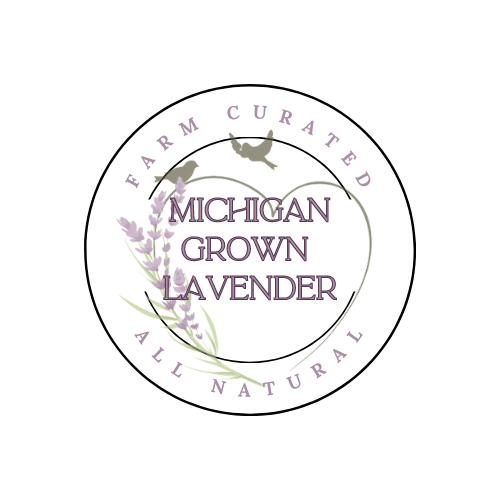About Grosso
Grosso Lavandin, or Lavandula x intermedia ‘Grosso’, was discovered in France in 1972 by a lavender grower named Pierre Grosso and named after the lavender farmer who discovered it. Grosso lavandin is renowned for its sharp, camphorous scent that tingles the nose of those who encounter it. Grosso plants and flowers are also a favorite to essential oil producing lavender farmers due to its generous output of oil.
As a large lavender hybrid variety that grows to 36″T x 30″W at maturity, Grosso was planted on our lavender farm purely for aesthetic value in regards to guest experience. We specialize in English Lavenders but we found that guests are somewhat visually turned off by the compact nature of true lavender.
Grosso is a suitable perennial for USDA hardiness zones 5-10. This works well for our lavender farm USDA hardiness zone 6 in Michigan AND I had a monster Grosso plant in my landscape when I lived in zone 9 Las Vegas. This proves that Grosso is adaptable to many different environments! Grosso is a late bloomer on our farm with magnificent long stems and large violet blue blossoms.
Grosso is technically not Lavender, it is “Lavandin”
It’s worth noting that lavandin is often mistaken or confused with true English lavender due to their similar appearance. However, their differences in fragrance profile and growth habits set them apart. While both species have their own unique qualities and uses, lavandin offers a captivating alternative that adds depth and complexity to any lavender garden design.
Lavandin, scientifically known as Lavandula x intermedia, is a fascinating hybrid species that is a cross between English Lavender (Lavandula angustifolia) and Portuguese Lavender (Lavandula latifolia). This unique combination gives lavandin its distinct characteristics and qualities.
Unfortunately ,all lavandins are purely aesthetic on our farm and considered a “junk crop” for us and we are here to explain why.
What is Grosso Lavandin Good For?
Grosso for Aromatherapy

Lavandin stands out from true lavender in terms of its chemical composition. It contains higher levels of camphor, which contributes to its distinctive and stimulating (almost nose hair burning) scent when the flower is squeezed. When Grosso is distilled, it has almost “hay-scented” undertones. Something I have noticed with both the oil and the dried buds.
English lavender is highly prized in the world of aromatherapy, often considered the gold standard for its soothing and calming properties. It contains high levels of linalool, a naturally occurring compound known for its relaxing effects on both the mind and body.
Lavandin is a very generous oil producer however, its camphor profile makes it a natural stimulant. English lavender is a natural sedative with a high linalool profile. So lavandin will produce a very opposite intended result than its English lavender counterpart. People often come to us and say “lavender keeps me up all night.” It’s pretty frustrating to explain the differences and the fact they may have been sold something that kind of smells like lavender but does not have the same constituents as lavender.
English lavender is technically deemed safe for all ages. Lavandin comes with severe contraindications. Pregnant, nursing, babies, young children and epileptic individuals should steer clear of lavandin. These contraindications are the reason we do not process our lavandin and put it in our lavender shop. Lavandin is a junk crop and purely exists for guest experience on our farm.
That being said, Grosso essential oil does have aromatherapy applications. It is always recommended to seek medical advice before adding aromatherapy to your routine. Grosso lavandin strong camphorous aromatherapy benefits may include: muscle ache relief, headache relief, natural insect repellent, cough and cold relief.
Whether the small distiller’s intentions are ignorant to the difference between selling the two or not, it is important that a lavender essential oil lover learns the difference between Lavender vs Lavandin. Not only are the constituents different, the price tag is very different as well. Grosso and lavandin oil, in general, is difficult to unload on the market at “lavender oil prices.” The real market price for lavandin is in line with common inexpensive essential oils such as peppermint oil or eucalyptus oil.
New Directions Aromatics goes into even greater depth in regards to lavandin oil and this is a highly recommended read. While you are there check out the prices of lavandin oil vs lavender oil. You will be shocked! Bulgarian true lavender oil costs twice (or 200%) the price of lavandin oil. True lavender originating from france costs four times (or 400%) the price of lavandin oil. So there you have it, you will never overpay for improperly marketed “lavender” essential oil again. You now know the difference and you will ask the small distiller questions before you spend your hard earned money on a bottle of oil that may be mislabeled!
Grosso Lavandin for Culinary Dishes
Due to Grosso’s high camphor content, it is not recommended for culinary dishes. If you ever had a culinary lavender delight that tasted like “soap,” you probably unintentionally ate a lavandin. Lavandin constituents, such as camphor, will also cause gastrointestinal upset. Always be careful where you source your culinary lavender!
Grosso Lavandin for Skincare
Spritz Grosso lavandin hydrosol in your hair for a “next day no-poo alternative” or on your face for a balancing toner.
Grosso Lavandin for Crafts
Unfortunately Grosso lavandin’s dry buds are not the most beautiful variety of dried lavender buds for wreaths, dried bundles or any type of craft that has the buds exposed. Grosso buds have a tendancy to lose their violet blue color as they dry. I guess what I am saying is their dried buds are outright ugly. Another problem that Grosso has is that it has a tendency to adopt a “hay” smell to it as it dries. And that is just yuck.
They do lend a beautiful sized stalk in lavender wands (where the buds are hidden from sight!) It is also recommended to use other varieties of lavender when weaving Grosso into your wand to mask the future “hay scent” when it dries.
Our farm personally uses the fresh Grosso blossoms to make floral arrangements for farmer’s markets:

Natural Bug Repellent
Lavandin naturally repels bugs, better than English lavender. I often forget to use insect repellent when I leave my property. Give the green lavandin leaves a squeeze to release the lavandin scent and rub the scent on your arms and legs or spray lavandin hydrosol directly on your skin to test the possibilities.
How to Plant & Care for Grosso Lavandin

Grosso lavandin prefers a sunny spot (8+ hours) plus well draining, alkaline and sandy soil with a soil pH between 6.7-7.3. Planting on a sunny slope will produce best results.
You should fertilize and prune your Grosso two times a year (at the same time.) I recommend dolomite lime as the only fertilizer that you use. Nitrogen heavy fertilizers will kill your plant or slow bud/flower production.
The first time will be a light prune when your lavandin is coming out of winter dormancy coupled with 1/4 cup of dolomite lime 6 inches from the base of the plant. The second time will be light prune when you are done harvesting coupled with 1/4 cup of dolomite lime 6 inches at the base of the plant. Unlike English lavender, it is not recommended to “hard prune” Grosso lavandin.
We do have a general comprehensive lavender growing guide available with more detailed information about creating the ideal conditions for your lavender garden..
Growing Grosso Lavandin from Seed
One important thing to note about lavandin is that it is sterile, meaning it does not produce seeds. This has practical implications for farmers and gardeners who cultivate this species, as they need to rely on propagation methods such as cuttings or cloning to propagate new plants.
IOW, if someone is selling “Grosso seeds,” it is a scam.
Growing Grosso Lavandin as an Indoor Plant
Lavandin does not have the same “compact” nature of English lavender. It’s root ball will become HUGE. Grosso will not be a happy plant if you try to get it to grow it indoors.
Grosso Lavandin Bloom Time on Our Farm
All of our lavandins are late bloomers on our farm. Our farm is located in a “microclimate” in Southwest Michigan. Our farm is one of the first to bud and bloom. There is only one other lavender farm located in the same microclimate that buds and blooms on the same cycle as our farm! Check out Michigan Lavender Bloom Schedules.
Grosso typically sends up its buds the week before Memorial Day on our farm. It takes a “hot minute” for Grosso’s magnificent stalks to mature and blossom. Grosso’s blooms start erupting the last several weeks on our farm. Grosso’s final blossoms are usually harvested by the 1st or 2nd week of July.
Again, we live in a bizarre microclimate so our lavender is first to arrive and first to depart in Michigan. If you want to see our Grosso in bud or bloom, I highly recommend following Twin Flame Lavender Farm’s facebook page where we give regular bud and bloom updates!
Harvesting and Processing Grosso Lavandin
Drying buds are not recommended as the buds will lose their color and the adopt a bizarre “hay-like” smell so they are less aesthetically appealing than other varieties that produce brilliant colored dried buds. I have smelled Grosso buds from many other lavender farms and I can assure you this “hay” smell is not just an anomaly on our farm!
On our farm we harvest Grosso for fresh floral arrangements only. As mentioned, Grosso, while pretty is a “junk crop” to us.
Since Grosso is one of our last blossoms to fade, the honeybees and bumblebees get a little aggressive as their food supply dwindles. We leave many stalks on the Grosso plants for the pollinators to enjoy at the end of the lavender season.

Live English Lavender Plant 6 Pack For Sale | Hydroponic Starts
Buy Lavender Plants in a 6 Pack and Save!
This English lavender plant offering is for six different varieties of “grower’s choice” rooted starter lavender plugs. You will be pleasantly surprised with our different varieties of lavender: we have purples, blues, pinks and white! Comes with planting and care instructions.

Lavender Infused Recipes Cookbook | INSTANT DOWNLOAD
This book will address common misconceptions surrounding cooking with lavender and provide expert tips on balancing its flavor profile in different dishes. By dispelling any doubts or uncertainties, we aim to empower even those who have never ventured into using lavender with cooking or baking before.
Renee started out as an avid real estate blogger in 2006. Opting for a less stressful life, Paul and Renee moved to Michigan in 2018 and started a lavender farm in 2019.
There are very few resources available to aspiring lavender farmers for growing lavender, lavender aromatherapy and lavender culinary infusion.
Renee hopes to change and shake up the world of lavender by sharing her knowledge and experience she has gained by being a lavender farmer and aromatherapist with lavender lovers all over the world.
Discover more from Twin Flame Lavender Farm Michigan
Subscribe to get the latest posts sent to your email.













